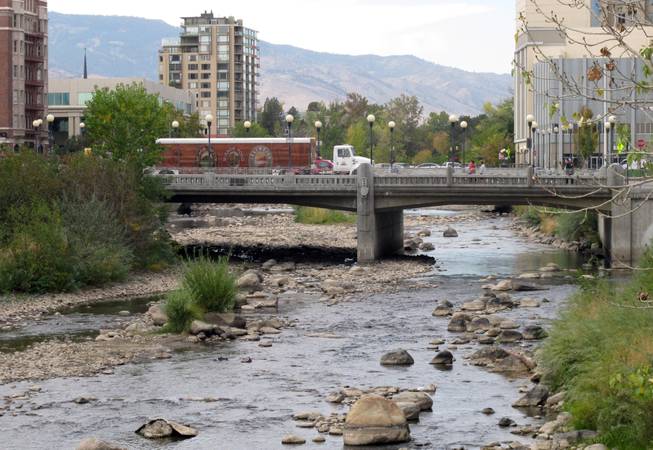
Scott Sonner / AP
Traffic crosses the Center Street bridge in downtown Reno on Friday, Oct. 17, 2014, over the Truckee River, which has been reduced to a shallow stream.
Published Friday, Oct. 17, 2014 | 2:22 p.m.
Updated Friday, Oct. 17, 2014 | 4:51 p.m.
RENO — Lingering drought has helped push Lake Tahoe's water level below its natural rim for the first time in five years, cutting off flows into the Truckee River, which has been reduced to a shallow stream as it meanders down the Sierra through Reno.
The Truckee Meadows Water Authority is confident it has more than enough reserves in a string of reservoirs downstream from Tahoe to meet water demand 30 miles away in the Reno-Sparks area into next summer.
But depending on winter conditions, agricultural users in the high desert east of Reno could face cutbacks on irrigation supplies for crops and livestock in the year to come.
"There's not a lot of water in the system," said John Erwin, the water authority's director of natural resources planning and management.
"It's typical this time of year you see water flows decline. But in a dry year like this, it's declining more than we like," he said Friday.
Chris Smallcomb, a National Weather Service meteorologist in Reno, said most of the Sierra has been struggling through below-normal precipitation since the "generous winter" of 2010-11. Since October 2011, Tahoe City, California, has received only 66 inches of precipitation compared with the normal 102 inches over three years, he said.
That's why federal water master Chad Blanchard predicted earlier this year that by fall, Tahoe would drop below its natural rim of 6,223 feet above sea level. It did this week — the first time since October 2009. On Friday, it was at 6,222.9 feet.
The lowest level on record was 6,220.2 feet on Nov. 30, 1992. It also dropped below rim level multiple times in the late 1920s, early 1930s and 1970s.
Relatively small changes in water level can have big impacts because Tahoe is so large.
With a depth of 1,654 feet — second in the U.S. only to Oregon's to Crater Lake — Tahoe has enough water to cover the entire state of California 14 inches deep. Normal evaporation alone drains 219 million gallons a day. That's 80 billion gallons a year — enough water to supply more than 500,000 households.
Truckee River outfitters who normally run their rafts in the rapids through October shut down at the end of July.
Last month, Truckee flows near the state line just west of Reno were their lowest in two decades for this time of year, running at 140 cubic feet per second compared with the normal 400 cfs. On Friday, the flows fell to 70 cfs as they entered Reno.
"We're heading into our big snow months, so hopefully there will be a turnaround for our water supply," Erwin said. He said a century of snowpack data show it's "very unusual to see these dry periods go beyond two or three years."
"We are heading into that fourth year, so it could be a new record," Erwin said. "But we plan for the worst case."
The National Oceanic and Atmospheric Administration expects above-average temperatures and precipitation in December through February across most of the West.
But warmer temperatures typically reduce the chance of big storms, said Zach Tolby, weather service meteorologist. As a result, the Sierra has an equal chance of above- or below-average precipitation, he said.
"I'm hoping for at least an average winter, if not more," Tolby said. "Average winters in the Sierra are great, and we haven't seen one in a while."

Join the Discussion:
Check this out for a full explanation of our conversion to the LiveFyre commenting system and instructions on how to sign up for an account.
Full comments policy